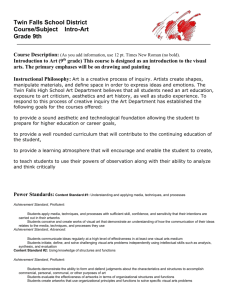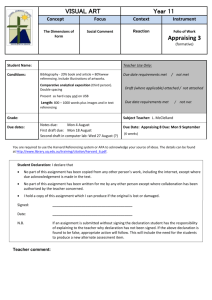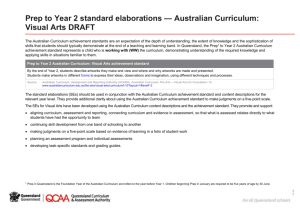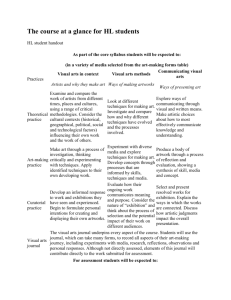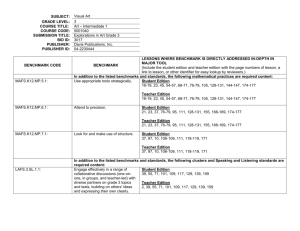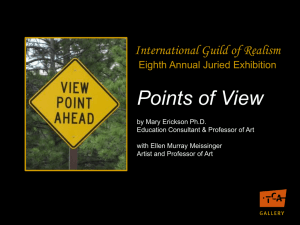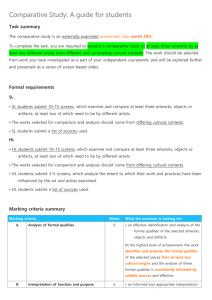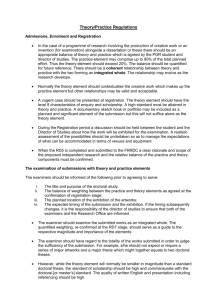Visual Arts - Queensland Curriculum and Assessment Authority
advertisement
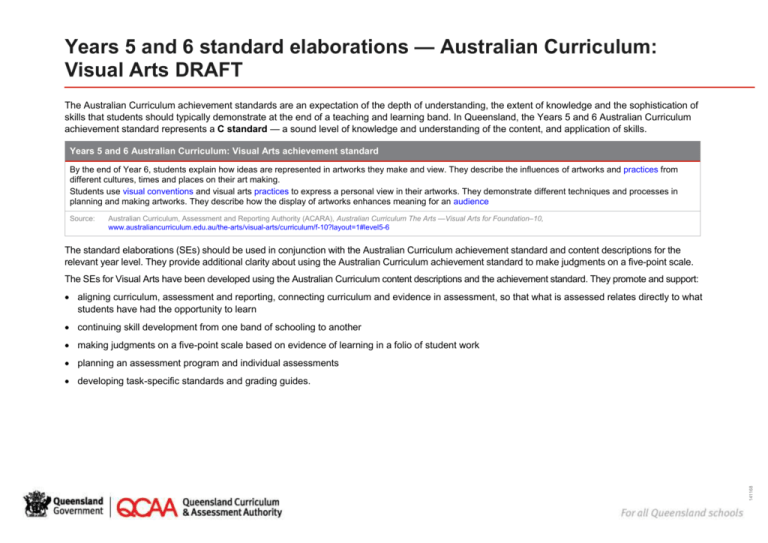
Years 5 and 6 standard elaborations — Australian Curriculum: Visual Arts DRAFT The Australian Curriculum achievement standards are an expectation of the depth of understanding, the extent of knowledge and the sophistication of skills that students should typically demonstrate at the end of a teaching and learning band. In Queensland, the Years 5 and 6 Australian Curriculum achievement standard represents a C standard — a sound level of knowledge and understanding of the content, and application of skills. Years 5 and 6 Australian Curriculum: Visual Arts achievement standard By the end of Year 6, students explain how ideas are represented in artworks they make and view. They describe the influences of artworks and practices from different cultures, times and places on their art making. Students use visual conventions and visual arts practices to express a personal view in their artworks. They demonstrate different techniques and processes in planning and making artworks. They describe how the display of artworks enhances meaning for an audience Source: Australian Curriculum, Assessment and Reporting Authority (ACARA), Australian Curriculum The Arts —Visual Arts for Foundation–10, www.australiancurriculum.edu.au/the-arts/visual-arts/curriculum/f-10?layout=1#level5-6 The standard elaborations (SEs) should be used in conjunction with the Australian Curriculum achievement standard and content descriptions for the relevant year level. They provide additional clarity about using the Australian Curriculum achievement standard to make judgments on a five-point scale. The SEs for Visual Arts have been developed using the Australian Curriculum content descriptions and the achievement standard. They promote and support: aligning curriculum, assessment and reporting, connecting curriculum and evidence in assessment, so that what is assessed relates directly to what students have had the opportunity to learn continuing skill development from one band of schooling to another making judgments on a five-point scale based on evidence of learning in a folio of student work planning an assessment program and individual assessments 141168 developing task-specific standards and grading guides. Years 5 and 6 Visual Arts standard elaborations A B C DRAFT D E Key Responding thorough explanation of how ideas are represented in artworks made and viewed informed explanation of how ideas are represented in artworks made and viewed explanation of how ideas are represented in artworks made and viewed description of how ideas are represented in artworks made and viewed statements about ideas in artworks thorough description of: – the influences of artworks and practices from different cultures, times and places on own art making informed description of: – the influences of artworks and practices from different cultures, times and places on own art making description of: – the influences of artworks and practices from different cultures, times and places on own art making identification of: – the influences of artworks and practices from different cultures, times and places on own art making statements about: – influences of artworks and practices from different cultures, times and places on own art making – how the display of artworks enhances meaning for an audience Making Knowledge, understanding and skills The folio of student work has the following characteristics: demonstration of different techniques and processes when planning and making artworks that clearly express a personal view through the skilful and effective use of: visual conventions visual arts practices. – how the display of artworks enhances meaning for an audience demonstration of different techniques and processes when planning and making artworks that clearly express a personal view through the effective use of: visual conventions visual arts practices. – how the display of artworks enhances meaning for an audience – displays of artworks that enhance meaning for an audience – displays of artworks enhancing meaning for an audience demonstration of different techniques and processes when planning and making artworks that express a personal view through the use of: demonstration of techniques and processes when making artworks that replicate a view through the use of aspects of: making of artworks that demonstrate sporadic use of aspects of: visual conventions visual arts practices. visual conventions visual arts practices. techniques processes visual conventions visual arts practices. Shading emphasises the key aspects of the achievement standard and qualities that discriminate between the A–E descriptors. Key terms are described overleaf. Years 5 and 6 standard elaborations — Australian Curriculum: Visual Arts DRAFT Queensland Curriculum & Assessment Authority March 2015 Page 2 of 5 Notes Examples of knowledge and skills in Years 5 and 6 Visual Arts ACARA provides examples of knowledge and skills in Visual Arts across each band, and they are provided here for your reference. Years 5 and 6 In this band students develop their knowledge of how ideas and intentions are communicated in and through visual arts. They build on and refine their knowledge, understanding and skills through visual arts practices focusing on: representation – subject matter such as environment (macro/micro), physical and conceptual properties of materials and technologies – forms cross-media — drawing, design, painting, sculpture, printmaking, photography, film, etc. – styles figurative, expressionistic, abstract, surrealism, Dada, digital art, etc. – techniques collage, drawing, screen printing, digital imaging, construction and environmental sculpture – visual conventions identifying, using and interpreting a selection of design elements and design principles – materials understanding of possibilities and restraints (qualities) of a range of materials – technologies traditional and digital practices – spaces recognising the meaning of studio, and adopting appropriate behaviour in the studio as a specialised space (e.g. cleaning up, organising materials, naming work and exhibiting work) presenting artworks in formal and informal spaces to enhance meaning; influence of viewpoints and audience on artworks; form and function – skills expressive — interpreting subject matter through various contexts and/or viewpoints to enhance understanding and create a personal response to stimuli conceptual — developing a thought or idea into a visual representation practical — using visual arts materials, equipment and instruments – processes investigating, conceiving, experimenting, selecting, refining, predicting, testing, evaluating, comparing, analysing, identifying, evaluating, judging and displaying viewpoints – expression — physical, psychological, sensory and intuitive – contexts — recognising artists and artworks who work in cross-media and those who install their artworks in various locations (refer to artists and audiences from different cultures, particularly Aboriginal and Torres Strait Islander Peoples, and from Asia). (ACARA, Examples of knowledge and skill in Visual Arts, www.australiancurriculum.edu.au/the-arts/visual-arts/Examples#5-6) Years 5 and 6 standard elaborations — Australian Curriculum: Visual Arts DRAFT Queensland Curriculum & Assessment Authority March 2015 Page 3 of 5 Australian Curriculum valued features The SEs describe the qualities of achievement in the two valued features for Australian Curriculum Arts achievement standards — responding and making. Valued features Description responding includes exploring, responding to, analysing and interpreting artworks making includes learning about and using knowledge, skills, techniques, processes, materials and technologies to explore arts practices and make artworks that communicate ideas and intentions Terms used in Years 5 and 6 Visual Arts SEs The following terms are used in the Years 5 and 6 Visual Arts SEs. They help to clarify the descriptors, and should be read in conjunction with the ACARA Visual Arts glossary: www.australiancurriculum.edu.au/the-arts/visual-arts/glossary. Term Description artist generic term for the maker of an artwork in each of the five Arts subjects aspects particular parts or features audience individuals or groups of people who experience the arts in a range of settings and contexts (formal, informal, virtual or interactive) through intellectual, emotional and social engagement; the artist is audience to their own artwork clear easy to perceive, understand, or interpret description; describe give an account of characteristics or features design elements include line, colour, shape, texture, space and form found in artworks, and incorporated in the design of performance spaces (including sets) for dance and drama design principles accepted conventions associated with organising design elements and can include unity, balance, hierarchy, scale, proportion, emphasis, similarity and contrast effectively; effective meeting the assigned purpose in a way that produces a desired or intended result; in Visual Arts, meeting the purpose by producing a strong impression explanation; explain provide additional information that demonstrates understanding of reasoning and/or application form; forms in each Arts subject, form is the whole of an artwork created by the elements and the way they are structured; in Visual Arts, two-dimensional form (2D), three-dimensional form (3D) and four-dimensional form (4D); see ACARA’s Examples of knowledge and skills in Years 5 and 6 Visual Arts fragmented disjointed, incomplete or isolated identification; identify establish or indicate who or what someone or something is informed having relevant knowledge; being conversant with the topic; in Visual Arts, includes how the knowledge and skills (representation and practices) work together to communicate meaning or intent in and through visual arts Years 5 and 6 standard elaborations — Australian Curriculum: Visual Arts DRAFT Queensland Curriculum & Assessment Authority March 2015 Page 4 of 5 Term Description materials physical resources, equipment including technologies, and information used to make artworks (e.g. paint, digital camera, pencil, drum and/or clarinet); see ACARA’s Examples of knowledge and skills in Years 5 and 6 Visual Arts practices the application of Arts skills and knowledge to create, represent, communicate and respond in a specific art form; see ACARA’s Examples of knowledge and skills in Years 5 and 6 Visual Arts relevant connected to the matter in hand replication to make a copy of; reproduce representation the expression or designation of a character, place, idea, image or information by some other term, character, symbol, diagram, image, sound or combination of visual and aural expression, based on shared social values and beliefs; in Visual Arts, a concept; see ACARA’s Examples of knowledge and skills in Years 5 and 6 Visual Arts skilful in Visual Arts, in the context of: creating artworks, this includes discerning selection, management and application of the design elements and principles of Visual Arts; sharing artworks, this includes a high degree of proficiency and polish sporadic appearing, happening now and again or at intervals; (irregular) or occasional statement; state a sentence or assertion style the influencing context of an artwork (e.g. impressionism in Visual Arts); see ACARA’s Examples of knowledge and skills in Years 5 and 6 Visual Arts technique in Visual Arts, the manner of making or skills used in making an artwork; see ACARA’s Examples of knowledge and skills in Years 5 and 6 Visual Arts technologies the tools and equipment that can be materials for making and responding; see ACARA’s Examples of knowledge and skills in Years 5 and 6 Visual Arts thorough demonstrating depth and breadth of visual arts knowledge and skills viewpoints a collection of perspectives, lenses or frames through which artworks can be explored and interpreted; see ACARA’s Examples of knowledge and skills in Years 5 and 6 Visual Arts visual conventions combinations of components and approaches, such as combinations of elements, design principles, composition and style; see ACARA’s Examples of knowledge and skills in Years 5 and 6 Visual Arts Years 5 and 6 standard elaborations — Australian Curriculum: Visual Arts DRAFT Queensland Curriculum & Assessment Authority March 2015 Page 5 of 5

